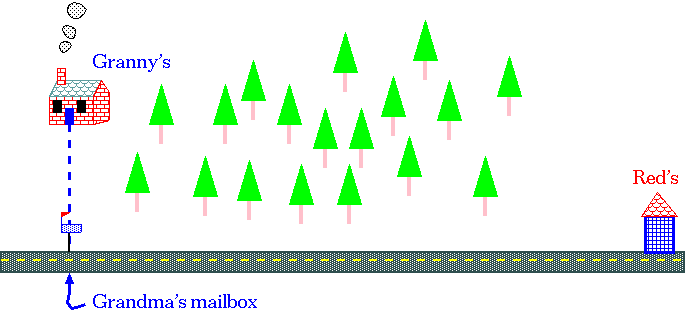On-line Math 21
On-line Math 21
4.3 Max-min problems
Example 3
Little Red Riding Hood
 Little Red Riding Hood is on her way to Grandma's house. Red lives 10 miles
down the (straight) road from Grandma's mailbox, which is the closest point
on the road to Grandma's house. The house itself is Ö3 miles from
the road, in the woods. Now, Red can walk 4 miles per hour on the road, but
only 2 miles per hour in the woods, since she has to keep looking out for the
Big Bad Wolf. What Red plans to do is, at some point between her house and Grandma's
mailbox, to leave the road and walk in a straight line to Grandma's house, through
the woods. Where should she leave the road, if she wants to get to Grandma's
house in the least amount of time?
Little Red Riding Hood is on her way to Grandma's house. Red lives 10 miles
down the (straight) road from Grandma's mailbox, which is the closest point
on the road to Grandma's house. The house itself is Ö3 miles from
the road, in the woods. Now, Red can walk 4 miles per hour on the road, but
only 2 miles per hour in the woods, since she has to keep looking out for the
Big Bad Wolf. What Red plans to do is, at some point between her house and Grandma's
mailbox, to leave the road and walk in a straight line to Grandma's house, through
the woods. Where should she leave the road, if she wants to get to Grandma's
house in the least amount of time?
Solution
The hardest part here is in keeping straight what you want to minimize. It's
also difficult to set up, since you need to have the right variables. Set x
to be the distance from Grandma's mailbox to the place where Red leaves the
road and heads into the woods.
 The time that she spends on the road, Troad , is
The time that she spends on the road, Troad , is
the distance she walks on the road, 10-x miles, divided by the speed,
4 miles per hour. The reason that you divide by the speed is best explained
in terms of the units:
|
|
miles
(miles/hour)
|
= hours. |
|
Now, through the woods, while watching out for the Big Bad Wolf, she is moving
only 2 mph, so her time Twoods through the woods is
So, the total time it takes to get to Grandma's house is
This is what we have to minimize. There really isn't a constraint in this one,
You do need to worry about the domain of T(x) as a function of x
, though. Certainly, Red won't start out heading the wrong way from her house,
and then cut into the woods, so x £ 10 . It is within the realm of possibility,
though, that x = 10 , which simply means she heads straight through the
woods. On the other hand, there is no point in going on past Grandma's mailbox,
either, since that would only add time. It might be a good idea, though, to
go to the mailbox, if for nothing more than to pick up Granny's mail. So
is the domain.
We find the critical points by differentiating, setting the derivative to 0,
and solving for x :
or
which of course means that x = 1 because of the domain.
There is still a problem. We have found a critical point, but we do not yet
know that it is where the minimum occurs. Unlike other problems we've dealt
with, the endpoints here do not have obviously non-optimal values of T .
We have, instead,
| x | T(x) |
|
|
| 0 |
| |
10
4
|
+ |
Ö3
2
|
= |
10+2Ö3
4
|
@ 3.366
|
|
| 1 |
|
| 10 |
|
So, it seems like the interior critical point is the minimum.
There is a way to tell that this value of x is the minimum without using
a computer (which is what I did - of course, since you are reading this on
a computer, it probably should not be viewed as a bad thing to use one). It
still is useful to see how to find which is the minimum by analyzing the situation,
rather than by computation. Notice that the derivative T¢(x) has the
following signs:
 So, the point x = 1 is a local minimum point, by the first derivative test.
Notice, though, that since the function increases from x = 1 to x = 10 ,
certainly the value at 10 is larger than at 1. Also, since the function decreases
from x = 0 to x = 1 , the value at 0 is also larger than at 1. You
don't need to know the values at the endpoints, since they have to be larger
than at x = 1 .
So, the point x = 1 is a local minimum point, by the first derivative test.
Notice, though, that since the function increases from x = 1 to x = 10 ,
certainly the value at 10 is larger than at 1. Also, since the function decreases
from x = 0 to x = 1 , the value at 0 is also larger than at 1. You
don't need to know the values at the endpoints, since they have to be larger
than at x = 1 .
So, the minimum has to happen at x = 1 , and she should cut into the woods
one mile from Granny's mailbox, or after walking 9 miles from her house.
Copyright (c) 2000 by David L. Johnson.
File translated from
TEX
by
TTH,
version 2.61.
On 8 Dec 2000, 00:23.



